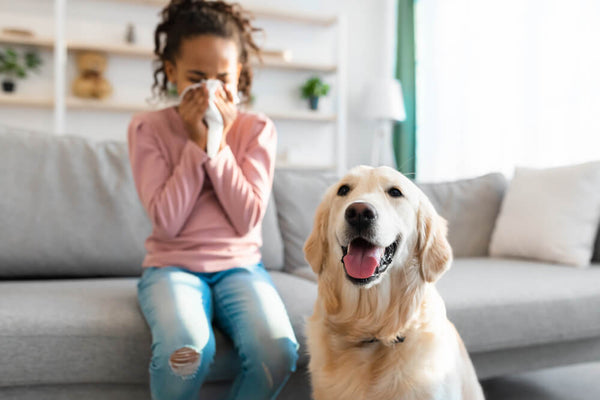Many around the world love having the companionship of a furry friend in their home, despite having allergic reactions to them. However, this doesn’t mean that it’s impossible for those with pet allergies to have a pet!
In this article, we will be sharing some of the causes, symptoms, possible treatments as well as tips to help you better adapt to coexisting with your pets at home.
Is It An Allergic Reaction To Pets?

The first step in learning to combat any allergy is to determine the cause. Make sure to rule out any other factors that may be contributing to your allergies such as dust, pollen, food, medication, and so on.
With thick, dense coats, it is also possible for cats and dogs to trap mould, pollen, dust and other external allergens in their fur, which could trigger your allergic reaction instead.
Symptoms Of Pet Allergies
The following are some common symptoms of an allergic reaction to pets.
- Swelling, itchy and/or watery eyes and nose.
- Red, itchy skin.
- Breathing problems.
- Coughing, wheezing, sneezing.
- Rash on the face, neck, upper chest.
- Asthma attacks (if you have pre-existing asthma).
Depending on the severity, these symptoms might appear immediately, or may take a few days to surface.
Causes Of Pet Allergies

An allergic reaction occurs when the immune system overreacts to a harmless substance known as an allergen. In the case of pet allergies, the allergen is usually not pet fur, but instead the saliva, sweat, pee or dead skin cells that are trapped in a cat or dog’s coat.
Some proteins in urine and saliva have been found to result in mild to severe allergic reactions in humans. For example, if you suddenly break out in a rash or hives after your cat or dog licks you, you may be allergic to their saliva.
These pet allergens can also collect on furniture and surfaces, staying on your walls, floors, clothing and more, causing the allergic reaction to persist even after a pet leaves.
Does That Mean I’m Allergic To All Pets?

That’s not always the case! Not all pets produce the same proteins, of which might be the one causing your allergic reaction. Moreover, even happens within the same cat/dog breed. Hence, it is usually dependent on the individual dog and owner.
Additionally, allergen levels can differ among the different breeds. Even though there isn’t a 100% allergen-free cat or dog breed (including hairless breeds), pets that don’t shed, are hairless or have short, single-layered coats are less likely to trigger allergies.
Depending on the severity of your allergies, with some maintenance and care, it is possible to help mitigate some of the symptoms so you can live peacefully with a cat or dog.
Treatments For Pet Allergies

You may want to turn to some over-the-counter antihistamines for relief, however it might not be a good idea to take them for prolonged periods of time. Hence, if you suspect that you are allergic to your pet, it is best to speak to your doctor.
However, if you have severe allergic reactions to pets, your doctor might recommend avoiding contact with any cats or dogs. Pet allergies can be very dangerous for some people, and should not be taken lightly.
Tips On How To Coexist With Your Pet(s)

If you or someone in your household is allergic, the following are some things you can do to live with a furry friend at home.
1. Create Boundaries
Try to keep your pet out of your bedroom as much as possible, or some rooms that you might spend a lot of time in. If it’s a household pet, try keeping interaction with it to a minimum and wash your hands often.
2. Get An Air Purifier
Air purifiers are beneficial for many reasons. If anyone in your home suffers from any type of allergies or respiratory ailments, you can consider investing in a high quality HEPA air purifier.
HEPA filters are designed to remove dander, pollen, dust mites and other airborne pollutants from the air in your home. Remember to clean and/or replace the filter/purifier as needed to maintain a healthy air quality in your home, both for you and your pets.
3. Groom/Bathe Your Pet Regularly
Grooming and bathing your cat or dog on a regular basis can help reduce the amount of dander. This should ideally be done by someone in the house that isn’t allergic, or a professional groomer. As allergens can remain in the bathroom, make sure to clean thoroughly afterwards.
4. Keep Your House Clean
Generally, the best way to help mitigate pet allergies is to properly clean your home. Wash linens such as bedding or clothes frequently. Mop, vacuum and clean all surfaces regularly (pet-safe cleaners are ideal here!).
Looking for a full list of ‘allergy-friendly’ dog breeds? Make sure to read our article on Hypoallergenic Dog Breeds here!


